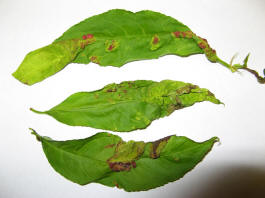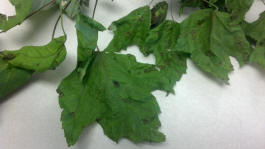 |
|
Peach
leaf curl |
 |
|
Anthracnose |
This week's highlights -- or lowlights
By John Fulton
 Send a link to a friend
Send a link to a friend
[May
22, 2013]
What a difference a year makes!
Last year we were warm and dry for large parts of the spring, and
this year has been cool and damp for the most part. With the type of
weather we have experienced, it should have been expected that many
different diseases would come our way this spring. Well, they are
here. Here are some shorts on the past week and some of the diseases
found without looking too hard.
Peach leaf curl is caused by a fungus on trees in the stone
fruit family. This would include mainly peaches and plums. It is
rather striking with the bright red swellings on the green
leaves. This disease can only be prevented with a dormant-time
application of a fungicide on your trees. Seeing it now means
that you probably should have sprayed before the buds began to
swell (meaning before leaves actually came out).
|
|
 Anthracnose
starts as dead areas between leaf veins or on the tips of
leaves. When severe enough, leaves will fall. Several of the
infected trees have actually had the leaves turn completely
black already. On many trees, it is much more noticeable on one
side, due to air movement carrying the disease and drying out
foliage quickly. The good news is that it rarely harms trees. If
enough leaves drop, a new set comes out in four to six weeks and
we start all over. The next set of leaves may also get the
disease, but they may not. Infection can continue with weather
favorable to the disease and when nighttime temperatures stay
under 65 degrees. Treatments when you see the symptoms of this
disease are simply wasted time and money. Anthracnose
starts as dead areas between leaf veins or on the tips of
leaves. When severe enough, leaves will fall. Several of the
infected trees have actually had the leaves turn completely
black already. On many trees, it is much more noticeable on one
side, due to air movement carrying the disease and drying out
foliage quickly. The good news is that it rarely harms trees. If
enough leaves drop, a new set comes out in four to six weeks and
we start all over. The next set of leaves may also get the
disease, but they may not. Infection can continue with weather
favorable to the disease and when nighttime temperatures stay
under 65 degrees. Treatments when you see the symptoms of this
disease are simply wasted time and money.
Apple scab, a disease similar to anthracnose, can cause
premature leaf drop in apples and crabapples. If you are on a
regular spray schedule for fruit trees, it should prevent most
of the problems. You could also spray crabapples this way, but
you would have to weigh the cost and benefit since no fruit
production is involved.

As a reminder, spray programs for disease prevention in fruit
trees should be applied every 10-14 days after the bloom period
is over. It should be stressed that these are preventive
programs and not curative. These programs then continue until
roughly two weeks before the fruit is ready to harvest.
[to top of second column] |

Garden update
Just to catch up on a few things, we are now ready for the
warm-loving vegetables to be planted. This would include lima beans,
cucumbers, eggplant, melons, sweet potato slips, and summer and
winter squash. You would want to accomplish these plantings around
June 1 at the latest for summer harvests.
In another two weeks or so, we'll begin planting for fall garden
harvests already, with plants such as potatoes, summer squash and
tomatoes.
You can also do second-crop planting of sweet corn, green beans
and cucumbers. Just remember, the length of time between your first
and second plantings will not equal the time between the harvests.
Heat units and length of night affect the crops. Heat units
accumulate much faster during the summer months, and the length of
night will be equal on either side of the summer solstice.
[By
JOHN FULTON,
University of Illinois Extension] |